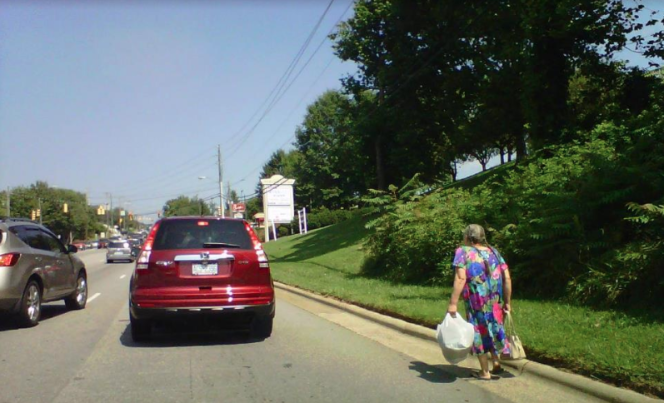Federal officials are failing to protect pedestrians — and may even be contributing to the problem as the pedestrian death toll has increased 50 percent in just eight years, advocates and experts say.
Roughly 6,000 pedestrians were killed last year — roughly 16 per day — the most since the early 1990s and a 46-percent increase since 2009. The worrisome trend doesn't seem to be reversing in part because federal authorities aren't focused on keeping pedestrians safe.
"We know what to do, we just are not doing it," Kate Kraft, director of America Walks told Streetsblog. "I don’t think anyone’s giving the level of attention that it really needs."
Take the National Highway Transportation Safety Administration. Its safety effort consists largely of pedestrian "education" efforts that some experts say are counterproductive.
"NHTSA is not putting nearly enough attention on speeding," said Sally Flocks, the director of the Atlanta-based pedestrian advocacy group, Peds. "They’re focusing primarily on alcohol and seat belts. Seat belts aren’t helping pedestrians. We’re not protected by airbags, child safety streets.
"Certainly alcohol is a problem, but it’s not primarily what’s killing pedestrians," she added. "It’s poor road design and speeding."
Atlanta offers a unique glimpse at the challenges: Gentrification of the urban core is pushing lower-income residents into the car-centric suburbs, where there is little infrastructure or design geared towards pedestrian safety. As a result, the region is one of the most dangerous areas for pedestrians in the nation. Flocks's group calls for engineering reforms such as more crosswalks, more sidewalks and more street lights.
Instead, NHTSA only funds education campaigns, such as those that remind pedestrians to cross at the crosswalks. Flocks believes that effort might actually worsen the problem by blaming the victim.
"The places where road fatalities are rising is in the mid-suburbs. Crosswalks are sometimes over a mile and a half apart," she said. "If you’e saying it was their fault they weren’t in a crosswalk, it takes the burden off the department of transportation."
The Federal Highway Administration is doing a better job, fusing some streetscape improvements in Atlanta aft making it a "focus city" for pedestrian safety. The funding has also been used to conduct "road safety audits" that can point out problems. But there are still huge gaps in support.
A key problem is that traffic safety officials have a cultural blindness to the dangers pedestrians face, says Flock, who experienced this first-hand when she gave up using her car and started taking the bus, only to feel vulnerable waiting at her stop as drivers sped by.
"You see the world so much differently when you’re not behind a windshield," she said. "It just becomes obvious how dangerous things are."
The problem, of course, is speeding. Last year, the National Transportation Safety Board sounded the alarm that driver impatience threatens to wipe out a decade of progress on traffic safety. But the messages and strategies from federal agencies like NHTSA haven't changed very much.
"The emphasis on speed nationally needs to be on par with drunk driving," said Bob Dallas, the former director of the Georgia Governor's Office of Highway Safety and a board member at the Vision Zero Network.
He also emphasized the need for better road design.
"Why aren’t we building infrastructure that supports the pedestrian on par with how we build infrastructure that supports vehicle traffic?" he asked.
The NHTSA does have a program called "Towards Zero Deaths," which seeks ambitious goals for dramatic reductions in road deaths, but it's not clear that the agency is making the wholesale changes to its policies and approaches that drastically reducing traffic deaths would require.
And the Trump administration has yet to appoint an administrator for the agency.
"I think all of us could do more collectively," Dallas said.
Part of the problem is political; there may be thousands of dead pedestrians, but far more political capital is spent on basic infrastructure like "crumbling bridges," Kraft said. And pedestrian advocates have less power than auto makers, drivers, transportation industry contractors and their lobbyists.
"There’s disagreement in the transportation world about what we should use precious transportation dollars on," she said. "I don’t think pedestrians have the same voice as road builders."
Streetsblog has reached out to the NHTSA for comment. When the agency responds, we will update this story.






